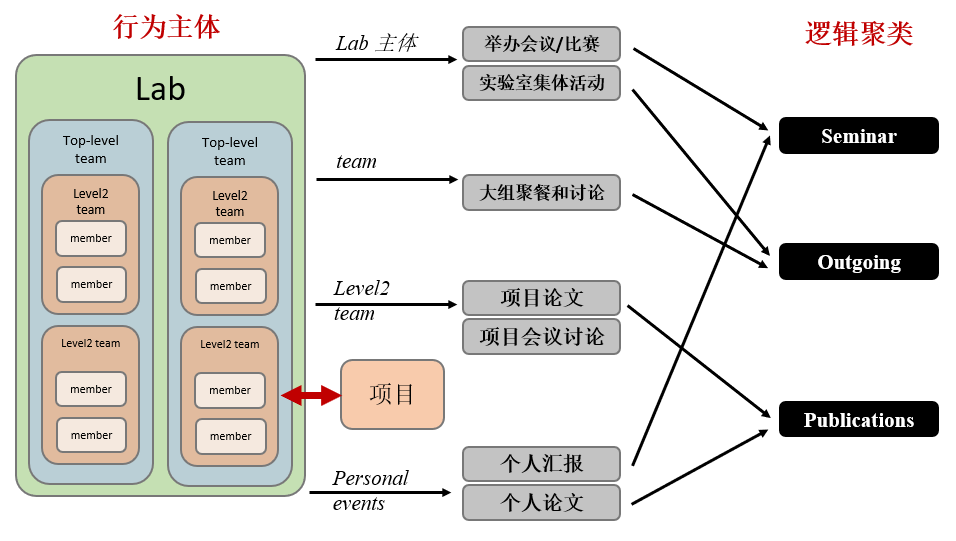Web Design 2 : Content Organization & Link Content using go template
导言
link hugo theme content using go template
内容组织¶
管理一个组织的人员和对应所属的基本信息(入学年份,工作去向)、成果(论文 和 项目)和新闻事件(获奖,组会汇报)。
采用数据库管理的思想,把后者拆分出元数据,并且以人名的驼峰字母拼音作为主键索引。
Hugo variables¶
作者与论文¶
- 文章作者 跳转到对应people page
- people page下列出所属论文
论文按照会议/CCF分级筛选¶
参考图片¶
数据库操作要求¶
Go template 需要做到以下几种操作:
变量的声明与使用¶
由于with会缩小.的变量域范围。我们需要提前保存我们要使用的变量(变量的作用范围仅在声明它的块内).
{{ $employment := .Params.employment }}
{{ with .Params.year_graduation }}
{{ if ne . "" }}
校友 <p>上一级职位:{{ $employment }}</p>
{{ end }}
{{ end }}
类型转换¶
读取任意位置文件的metadata 和 markdown 内容¶
读我自己写的content/path/home.yml里的元数据
如果你想读取特定内容文件(例如 content/path/home.yml)中的元数据,你可以使用类似的方法。假设你的 home.yml 文件如下:
在你的 Hugo 模板中,你可以使用以下方式读取这个文件中的元数据:2 并使用1
{{ with .GetPage "home.yml" }}
// .Params.Title also pass
{{ .Params.title }}
{{ .Params.description }}
{{ .Params.author }}
{{ end }}
这里使用了 with 来确保只有在找到相应页面的情况下才会输出元数据。请注意,这里假设 home.yml 文件的路径是 content/path/home.md,如果实际路径不同,你需要相应地调整路径参数。
某一文件夹下查找是否存在文件名是ABC的文件
在 Hugo 模板中,你可以使用 .Site.GetPage 函数来检查某个特定路径下是否存在指定的文件。以下是一个例子,检查在 content/myfolder/ 文件夹下是否存在名为 ABC.md 的文件:
{{ with .Site.GetPage "section" "myfolder" }}
{{ with .GetPage "ABC.md" }}
<!-- 文件存在的处理逻辑 -->
<p>文件存在:{{ .Title }}</p>
{{ else }}
<!-- 文件不存在的处理逻辑 -->
<p>文件不存在</p>
{{ end }}
{{ end }}
在这个例子中:
.Site.GetPage "section" "myfolder"用于获取myfolder这个部分(section)的页面。.GetPage "ABC.md"用于获取在myfolder部分下的ABC.md文件。
你可以根据需要调整路径和文件名。如果文件存在,你可以在 "文件存在的处理逻辑" 部分执行相应的操作,否则可以在 "文件不存在的处理逻辑" 部分处理。
遍历 与 筛选¶
- 包含key value
- key的数值大于k
遍历单一metadata的列表¶
people_line:
# slider item loop
- name : "An Hong"
image : "images/clients/anhong.png"
url : "http://cs.ustc.edu.cn/2020/0426/c23235a460072/page.htm"
designation : "Prof."
content : "Chip multiprocessor architecture, parallel computer system architecture, parallel programming environment and tools, large data parallel storage and processing, high performance computing"
- name : "Shi Jun"
image : "images/clients/client1.jpg"
# xxx
对应html
{{ range .Params.people_line }}
{{ .name }}
{{ .image | absURL }}
{{ .url | absURL }}
{{ .designation | markdownify }}
{{ .content | markdownify }}
{{ end }}
遍历子文件夹md,并根据metadata 筛选¶
{{ range .Data.Pages }}
<!-- 在每个页面内部,再次使用range循环遍历该页面的所有类别。 -->
{{ if eq (.Param "display_toc") "A" }}
{{ .TableOfContents }}
{{ else }}
<!-- 如果 display_toc 参数不等于 "A",执行这里的内容 -->
{{ end }}
{{ end }}
chatgpt's answer
在Hugo的Go模板中,你可以使用where函数结合条件来遍历子文件夹中的Markdown文件,并根据元数据(metadata)进行筛选。以下是一个示例,假设你想要遍历content/posts文件夹下的Markdown文件,然后根据文件的categories元数据进行筛选:
在上面的示例中:
where .Site.RegularPages "Section" "posts"用于获取content/posts文件夹下的所有Markdown文件。{{ with .Params.categories }}用于检查文章是否有categories元数据。{{ if in . "your_category" }}用于检查文章的categories中是否包含你感兴趣的特定类别(在这里用"your_category"作为示例,你需要替换为实际的类别名称)。- 如果文章符合条件,就在
<!-- 在这里处理符合条件的文章 -->注释下进行处理,你可以输出文章的标题、内容等。
请根据你的实际需求调整条件和处理逻辑。这只是一个示例,你可以根据自己的具体情况进行修改。在Hugo的Go模板中,你可以使用各种条件和函数来灵活地筛选和处理内容。
metadata的使用¶
存在并非空 的metadata¶
// 存在
{{ with .Params.year_graduation }}
// 判断非空
{{ if ne . "" }}
<p>职位:{{ . }}</p>
{{ end }}
{{ else }}
<p>没有提供职位信息</p>
{{ end }}
必须要有with
// Debug: Params.year_graduation = '%!s(<nil>)'
{{ printf "Debug: Params.year_graduation = '%s'" .Params.year_graduation }}
{{ if ne .Params.year_graduation "" }}
校友2
<p>职位:{{ .Params.year_graduation }}</p>
{{ end }}
go template 判断 <nil> ne ""
遍历、合并、去重各post的categories¶
<!-- 包含了一个特殊的data-toggle属性,用于指定这是一个按钮切换组。 -->
<div class="btn-group btn-group-toggle portfolio-navigation" data-toggle="buttons">
<label class="btn btn-sm btn-primary active hvr-sweep-to-right">
<input type="radio" name="shuffle-filter" value="all" checked="checked" />All
</label>
<!-- 定义了一个变量$categories,这是一个切片(slice)类型的变量,用于存储文章的所有类别。 -->
{{ $categories := slice }}
<!-- 遍历了所有网站页面(文章)。 -->
{{ range .Data.Pages }}
<!-- 在每个页面内部,再次使用range循环遍历该页面的所有类别。 -->
{{ range .Params.categories }}
<!-- 将每个类别追加到之前定义的$categories切片中。 -->
{{ $categories = $categories | append . }}
{{ end }}
{{ end }}
<!-- 使用range循环遍历去重后的类别切片。 -->
{{ range ( $categories | uniq ) }}
<!-- 对于每个类别,生成一个按钮标签 -->
<label class="btn btn-sm btn-primary hvr-sweep-to-right">
<input type="radio" name="shuffle-filter" value="{{ . | urlize }}" />{{ . | humanize }}
</label>
{{ end }}
</div>
数值metadata的计算和处理¶
日期2023-12 变成 Dec
在Hugo的Go模板中,你可以使用dateFormat函数将日期格式化为你所需的格式,并使用条件语句或类似的逻辑来映射月份的数字到英文月份缩写。下面是一个示例:
{{ $monthMapping := dict "01" "JAN" "02" "FEB" "03" "MAR" "04" "APR" "05" "MAY" "06" "JUN" "07" "JUL" "08" "AUG" "09" "SEP" "10" "OCT" "11" "NOV" "12" "DEC" }}
<p>{{ index $monthMapping (printf "%02d" .Date.Month) }}</p>
请注意,.Date.Month返回的是一个整数。
入学年份2021 变成 研究生几年级
同理映射 阿拉伯数字 变成 中文数字。
默认功能:排序date: 1923-12-02
<!-- 遍历所有页面,按照发布日期进行降序排序。.Pages表示网站的所有页面,.ByPublishDate表示按照发布日期排序,.Reverse表示降序排列。 -->
{{ range .Pages.ByPublishDate.Reverse }}
<p>
<!-- RelPermalink是相对于网站根目录的页面链接。 -->
<h3><a class="title" href="{{ .RelPermalink }}">{{ .Title }}</a></h3>
{{ partial "metadata.html" . }}
<a class="summary" href="{{ .RelPermalink }}">
<!-- Hugo automatically takes the first 70 words of your content as its summary and stores it into the .Summary variable -->
<p>{{ .Summary }}</p>
</a>
</p>
{{ end }}
是非判断¶
{{ if .Param "display_toc" }}
{{ .TableOfContents }}
{{ else }}
<!-- 如果 display_toc 参数不存在或为 false,执行这里的内容 -->
{{ end }}
// other
{{ if eq (.Param "display_toc") "A" }}
{{ .TableOfContents }}
{{ else }}
<!-- 如果 display_toc 参数不等于 "A",执行这里的内容 -->
{{ end }}
navigation bar & footer¶
config in config.yml
range site.Params is the global site configuration.
range 使用
according tomlhomepage¶
- manual designed content in
config.yml - 对应位置的
__index.md

